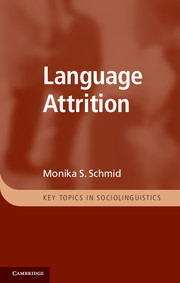Book contents
- Frontmatter
- Contents
- List of figures
- List of tables
- Preface
- Abbreviations
- 1 Introduction
- Part I Linguistic aspects of language attrition
- Part II Extralinguistic aspects of language attrition
- Part III Conducting research on language attrition – preliminary considerations
- Part IV Experimental designs for attrition research – the language attrition test battery
- Part V Coding and analysing the data
- 18 Conclusion
- Glossary
- Notes
- References
- Index
Part V - Coding and analysing the data
Published online by Cambridge University Press: 05 June 2012
- Frontmatter
- Contents
- List of figures
- List of tables
- Preface
- Abbreviations
- 1 Introduction
- Part I Linguistic aspects of language attrition
- Part II Extralinguistic aspects of language attrition
- Part III Conducting research on language attrition – preliminary considerations
- Part IV Experimental designs for attrition research – the language attrition test battery
- Part V Coding and analysing the data
- 18 Conclusion
- Glossary
- Notes
- References
- Index
Summary
Once you have gone out to collect your data, what do you do with it? How do you get from a large dataset of individual results to a group comparison of attrition effects? Part V will go into the processes of presenting, representing, analysing and interpreting your data.
There are two extremely scary moments in the course of any research project. The first occurs when you have done all your fieldwork and return with a pile of questionnaires, tapes, tests and whatever else you have collected, and you realize that the time has come where you have to start turning this rather chaotic pile into a well-structured database. The second comes when you actually have that well-structured database, and have to begin finding out what the data mean – that is, when you have to begin your statistical analysis. At these watershed moments, you first have to decide how to code and organize your data, and then how to analyse it.
Tip
I strongly advise sticking to this order – coding first, analysis later! You will, of course, be tempted to run intermediate analyses once you have finished a third, half, or three quarters of your coding – but these analyses will be worthless and take up a great deal of your time. The worst-case scenario here is that you conduct an analysis on a subsample and present the findings at a conference somewhere – only to discover later on that the findings from the whole dataset contradict the conclusions you had confidently asserted before.
- Type
- Chapter
- Information
- Language Attrition , pp. 197 - 198Publisher: Cambridge University PressPrint publication year: 2011



